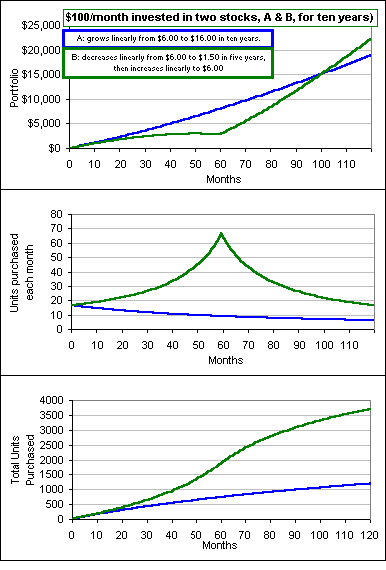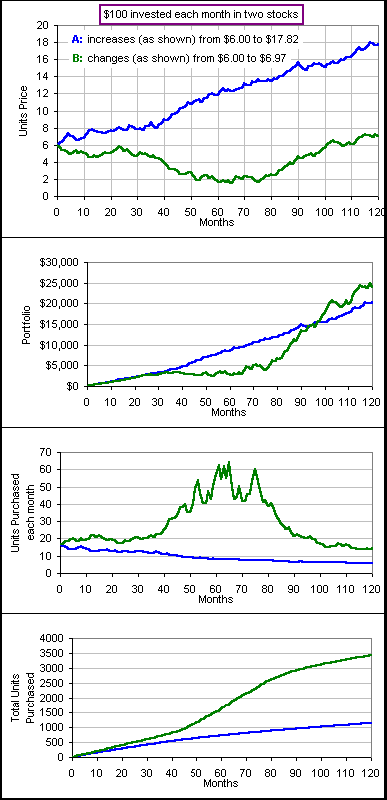I'm not a fan of Dollar Cost Averaging (DCA). Putting money into
investments at the end of each month (without thought, synchronized
with the phases of the moon) seems an admission of cerebral frailty.
So I decided to prove that waiting for a correction would have
been a better strategy (in the past, of course, since I can't predict
what'll happen tomorrow).
| PROLOGUE |
|---|
SAVE YOUR $100/month in Money Market (MM) UNTIL A CORRECTION,
then INVEST IT ALL AT ONCE.
(Of course, there are those who will argue that DCA is to reduce your risk, not to improve your return ... so I address this to those who want to maximize returns.)
I chose a very volatile market
(annualized return = 14% over this period), namely Pacific Large Cap,
with a Standard Deviation (SD) of 6.3% over this time period (compared
to U.S. Large Caps with SD=4.1%).
I considered nine strategies:
Keep putting your $100 each month into MM (at 5%/annum) until there are
FOUR successive drops in the (Pacific) market, then invest it all
at once. If the market drops again the following month, invest your $100
again. Continue until the market goes up, then switch to putting your
$100 into MM again ... waiting for the next drop for FOUR
consecutive months. (Below, I call this strategy DOWN-4.)
I repeated this strategy, waiting for corrections over THREE,
TWO, and ONE consecutive month(s), as well as waiting
until the market has gone UP for ONE, TWO,
THREE or FOUR months.
(These last strategies are for
those who mumble, "Aah, now we're on a roll ... time to jump in.")
In the following table, the value of your investment (in some FUND which mimics the Pacific Index) and the amount in MM and your TOTAL portfolio is given as of June, 1997 (assuming you began these strategies in Jan, 1975):
| STRATEGY | FUND | MM | TOTAL |
|---|---|---|---|
| DOWN-4 | $93,337 | $7,037 | $100,374 |
| DOWN-3 | $113,458 | $7,037 | $120,495 |
| DOWN-2 | $117,277 | $504 | $117,781 |
| DOWN-1 | $122,609 | $301 | $122,910 |
| DCA | $126,229 | $0 | $126,229 |
| UP+1 | $124,847 | $0 | $124,847 |
| UP+2 | $123,241 | $0 | $123,241 |
| UP+3 | $122,338 | $0 | $122,338 |
| UP+4 | $115,198 | $5,411 | $120,609 |
| EPILOGUE |
|---|
"That's okay HoneyBun, you're right sometimes," she sez. "You married me, didn't you?"
>So ... why does DCA work?
When the price goes down you buy more units with your monthly investment. Take a peek:

>So, you buy more units with your $100, at the lower prices?
Yes. This example is due to James Stowers, author of "Yes, You Can Achieve Financial
Independence".
Of course, linear changes in returns are unusual, so consider this:

No.
>Will it catch up if you change the percentage, from 1% to, say ...?
No.
>Can you prove that?
Yes. Want to see the proof?
>No. But if linear changes are unusual then so are smoooth percentage changes, eh?
Uh ... yes, so here's a more realistic scenario.

>So is DCA always best?
Of course, not. It depends upon the sequence of stock prices and the time interval and ...
>... and the weather in Bermuda?
Sure.
>So you're now a fan of Dollar Cost Averaging?
Nope. It requires a certain sociological profile, a certain genetic configuration, a
certain aversion to volatility, a certain comfort in ritual, a certain ...
>None of which you have.
Right. Besides, DCA has a Dark Side.
You can peruse the Fund Library thread that started all this.
Also, you may want to consider Value Averaging.
>A picture is worth a thousand ...
>You're comparing holding onto your stock or DCAing out at $100 per month, eh? >Buy high. Sell low.
In general, we'd want to ... uh ... Buy Low,
Sell High.
That means that if we're buying stock, then we're accumulating units.
The number of units purchased should be higher when the price, P, is lower.
That means we'd buy a fixed number of dollars worth,
say $A, so the number of units purchased is A/P and is inversely proportional
to the stock price. When the stock price is low, we'd buy more units.
That's Buy Low.
>Wrong colour.
On the other hand, if we were selling stock, we're probably accumulating dollars, to pay
for that trip to Hawaii. Then we'd might want to consider selling
fewer dollars worth when the price is low and selling more dollars worth when the price is high.
We could do that by selling a fixed number of units,
say N units.
>Instead of a fixed number of dollars. >Ain't there some formula, a mathematical gesticulation, a ...
It has some math, and ...
>I'd rather not.
>Wait! I assume that if DCAing into your investments is good, then ...
DCAing out is bad? Yes. If you think the market is going to go South, then you might consider
taking ALL your money out rather than a piece at a time. Withdrawing, say, $100 a month from
a $10K portfolio will guarantee that you sell more shares when the price is low and
fewer shares when the price is high. Further ...
Here's some pictures. You're investing in the S&P 500. You expect a downturn. You withdraw
$100 each month, putting it into Money Market at 3%. Compare your total monies
(stock + money market) if you do this DCA-out thing ... or
just hold onto the stock. Of course, if you sell everything and put the cash
under your pillow - you keep the $10K intact:


Right.
>I'd say you're better off with the money under the pillow.
Notice that when the S&P goes down, you sell more of the low priced stock. That's
like ...
Very clever.
>Thanks.
However, remember we're talking about getting out during a market downturn. You're better
selling all-at-once. On the other hand, if you needed a bunch of money, in a year or so -
and you're not expecting a downturn - you may be better off cashing in stock a bit at a time.
That's Buy Low.
Exactly. If we sold N units at the price P,
the dollar amount is then NP, so when the price is high we'd be selling
more dollars worth. That's Sell High.
Sure. You may (or may not) want to peek at Part II.
 for Part II: DCA for masochists
for Part II: DCA for masochists
.... you may want to look at the thread.
Of course, we might examine the consequences of withdrawing with either a fixed DOLLAR amount
or a fixed UNIT amount, assuming you start with N units of some stock (or mutual fund)
and withdraw for m months ... like so:
| Stock Price | Portfolio | Units Withdrawn | Remaining Units |
| P1 | N P1 | n1 | N - n1 |
| P2 | (N - n1)P2 | n2 | N - n1 - n2 |
| P3 | (N - n1 - n2)P3 | n3 | N - n1 - n2 - n3 |
| etc. | etc. | etc. | etc. |
| Pm | (N - n1 - n2 - ... - nm-1)Pm | nm | N - n1 - n2 - ... - nm |
>Uh ... if you say so.
Okay, then we want to maximize N - n1 - n2 - ... - nm
If we withdraw a FIXED number of UNITs, say U, then
n1 = n2 = ... = nm = U
leaving us with N - m U units.
On the other hand, if we withdraw a FIXED number of DOLLARs, say
$D, then
n1 = D/P1,
n2 = D/P2, ....
nm = D/Pm.
leaving us with N - D
(1/P1 + 1/P2 + ... + 1/Pm) units.
In order that our FIXED UNIT portfolio exceed our FIXED DOLLAR portfolio (after m withdrawals), we'd want to withdraw fewer total units. That is:
m U < D (1/P1 + 1/P2 + ... + 1/Pm)or, to put it differently:
(1) D / U > 1/{ (1/m) (1/P1 + 1/P2 + ... + 1/Pm) }
|
and we recognize (on the right-side) the reciprocal of the average reciprocal of the m stock prices.
>What! >No! | 
|
>So?
Well ... since we don't know the average reciprocal - these are future prices, remember -
then we'd probably say:
"I need $10,000 and the current stock price is $10 so I'll withdraw
100 units each month for 10 months"
That'd make U = 100 units, right?
On the other hand, we might say:
"I need $10,000 so I'll withdraw $1000 each month for 10 months"
That'd make D = $1000, right?
That makes D / U = $10.
>How do you know that 10 withdrawals, 100 units each time, will remove the same amount, $10K, from my portfolio?
Good question. If we withdraw D each month,
for m months, we've withdrawn m D dollars.
To withdraw the same amount, by withdrawing
U units each month, we need
U (P1 + P2 + ... + Pm)
= m D
and that means:
D / U = (1/m) (P1 + P2 + ... + Pm) = Average Stock PriceIn order to satisfy Equation (1) (so our portfolio with FIXED UNIT withdrawals exceeds our portfolio with FIXED DOLLAR withdrawals), we'd need:
(1/m) (P1 + P2 + ... + Pm) = Average Stock Price > 1/{ (1/m) (1/P1 + 1/P2 + ... + 1/Pm) }If course, we're talking about future prices ... so the question is: "Will they satisfy this inequality?"
>That's the question, but what's the answer?
I have no idea.
>A picture is worth a thousand ...
Okay, here's what we'll do:
- We have a $100K portfolio and we want to withdraw $20K over about 10 months.
- The current stock price is $10 ... and varies randomly!
- We can either:
- Withdraw a fixed dollar amount of $2K per month for ten months, or
- Withdraw 200 units each month for ten or eleven months ... with a lesser amount for the last month so the total amount withdrawn is exactly $20K
- Here are typical pictures, comparing Constant Unit withdrawals and Constant Dollar withdrawals:



>I don't see much difference ... so, what's best?
It depends upon the future ... wait'll I check.

